
OmniBook 2000/5700
Installation and Setup Guide

OmniBook 2000/5700
Installation and Setup Guide

Notice
This manual and any examples contained herein are provided ???as is??? and are subject to change without notice.
Consumer transactions in Australia and the United Kingdom: The above disclaimers and limitations shall not apply to Consumer transactions in Australia and the United Kingdom and shall not affect the statutory rights of Consumers.
?? Copyright
The programs that control this product are copyrighted and all rights are reserved. Reproduction, adaptation, or translation of those programs without prior written permission of
Portions of the programs that control this product may also be copyrighted by Microsoft Corporation, SystemSoft Corp., Advanced Micro Devices, Inc., Crystal Semiconductor Corporation, and Chips & Technologies, Inc. See the individual programs for additional copyright notices.
Microsoft, MS,
For warranty information, see the Support and Service booklet.
Hewlett
Mobile Computing Division
1000 N.E. Circle Blvd.
Corvallis, OR 97330, U.S.A.
ii

HP Software Product License Agreement
Your HP OmniBook PC contains
Carefully read this License Agreement before proceeding to operate this equipment. Rights in the software are offered only on the condition that the customer agrees to all terms and conditions of the License Agreement. Proceeding to operate the equipment indicates your acceptance of these terms and conditions. If you do not agree with the terms of the License Agreement, you must now either remove the software from your hard disk drive and destroy the master diskettes, or return the complete computer and software for a full refund.
Proceeding with configuration signifies your acceptance of the License Terms.
Unless otherwise stated below, this HP Software Product License Agreement shall govern the use of all software that is provided to you, the customer, as part of the HP computer product. It shall supersede any non
Note: Operating System Software by Microsoft is licensed to you under the Microsoft End User License Agreement (EULA) contained in the Microsoft documentation.
The following License Terms govern the use of the software:
Use. Customer may use the software on any one computer. Customer may not network the software or otherwise use it on more than one computer. Customer may not reverse assemble or decompile the software unless authorized by law.
Copies and Adaptations. Customer may make copies or adaptations of the software (a) for archival purposes or (b) when copying or adaptation is an essential step in the use of the software with a computer so long as the copies and adaptations are used in no other manner.
Ownership. Customer agrees that he/she does not have any title or ownership of the software, other than ownership of the physical media. Customer acknowledges and agrees that the software is copyrighted and protected under the copyright laws. Customer acknowledges and agrees that the software may have been developed by a third party software supplier named in the copyright notices included with the software, who shall be authorized to hold the Customer responsible for any copyright infringement or violation of this Agreement.
Product Recovery CD
iii

product recovery
Transfer of Rights in Software. Customer may transfer rights in the software to a third party only as part of the transfer of all rights and only if Customer obtains the prior agreement of the third party to be bound by the terms of this License Agreement. Upon such a transfer, Customer agrees that his/her rights in the software are terminated and that he/she will either destroy his/her copies and adaptations or deliver them to the third party.
Sublicensing and Distribution. Customer may not lease, sublicense the software or distribute copies or adaptations of the software to the public in physical media or by telecommunication without the prior written consent of
Termination.
Updates And Upgrades. Customer agrees that the software does not include updates and upgrades which may be available from
Export Clause. Customer agrees not to export or
U.S. Government Restricted Rights. Use, duplication, or disclosure by the U.S. Government is subject to restrictions as set forth in subparagraph (c)(1)(ii) of the Rights in Technical Data and Computer Software clause in DFARS
Edition History
iv

Contents



1
Starting Out with Your
OmniBook

Starting Out with Your OmniBook
Congratulations! Your OmniBook sets a new standard in personal computing. Although it???s compact and easy to carry, the OmniBook is infused with the quality and attention to detail that are the hallmark of
The OmniBook Quick Start sheet shows how to get your OmniBook up and running quickly. This Getting Started manual shows how to start using your OmniBook and it also shows what to do if you run into trouble.
Your OmniBook provides these additional manuals:
???The online OmniBook User???s Guide : This introduces the OmniBook and shows you how to operate and maintain your OmniBook. It also contains troubleshooting information. Look in the OmniBook Library group.
??? The Introducing Microsoft Windows 95 manual: This is shipped with your OmniBook and contains information about using the standard features of Windows 95.
???The online Windows Quick Start and
???The OmniBook Website at http://www.hp.com/go/omnibook
The Corporate Evaluator???s Guide at our Website provides complete information about installing alternate operating systems, as well as how to configure the OmniBook in a corporate, networked environment.

C A U T I O N
Starting Out with Your OmniBook
Setting Up the OmniBook
Setting Up the OmniBook
This chapter describes the
???Installing the battery.
???Connecting the ac adapter and charging the battery.
???Selecting a
To set up the OmniBook
1. Insert the battery. Use only an HP F1193B battery (or super F1194B).
2. Plug the power cord into the ac adapter, then into a grounded outlet.
Use only an HP F1140A or HP F1044B ac adapter. Using an improper adapter could damage the OmniBook and will make your warranty invalid.

C A U T I O N
C A U T I O N
Starting Out with Your OmniBook
Setting Up the OmniBook
The first time you plug in the ac adapter, let the OmniBook charge continually for at least 24 hours. This ensures that the OmniBook???s clock battery is fully charged. Otherwise, your OmniBook will not keep the correct date and time. Subsequent charging of the primary battery, during normal use, will maintain the clock battery???s charge.
The HP F1044B ac adapter used with this product is disconnected from the power by unplugging the power cord from the power outlet or from the ac adapter. Therefore, the power outlet should be located close to the product and be easily accessible.
3. Press the blue On/Suspend button.
The OmniBook will take half a minute or more to start. If the OmniBook does not turn on, press the Off button on the left side of the OmniBook, then press the blue button again.
To select one of the
This product offers a choice between two Microsoft operating systems:
???Windows 95, or
???Windows for Workgroups.

Recovery CD
Important
CAUTION
Starting Out with Your OmniBook
Setting Up the OmniBook
As part of the setup procedure, you must make a
Should you later need to reinstall the operating system, you can reinstall Windows 95 from the Recovery
When your OmniBook starts up the first time, it takes you through a series of setup screens, including installation of the operating system.
If you have a docking system, you should not have it connected during the installation of the operating system.
If you???re installing Windows for Workgroups
When prompted to do so, it is important that you make
1.Plug in the ac adapter.
2.Press the blue On/Suspend button.
The Windows 95 Setup program starts automatically. The Setup screens are labeled Windows 95, but they are for Windows for Workgroups, too.
After you accept the License Agreement and enter the Product ID (printed on the Certificate of Authenticity on the Microsoft Introducing Windows 95 book), you will see the Windows Version screen. If you choose Windows for Workgroups, the product ID is not necessary.

Starting Out with Your OmniBook
Setting Up the OmniBook
3. In the Windows Version screen, click the Change button.
4.Choose the following option:
No, I want to install
5.Click OK to continue the Setup program and install Windows for Workgroups.

Starting Out with Your OmniBook
Getting Comfortable
Getting Comfortable
This section introduces the OmniBook and shows you how perform some basic tasks. In this section you???ll learn how to
???Identify parts of the OmniBook.
???Adjust the display.
???Use the TrackPoint III pointing device.
???Adjust and use the OmniBook keyboard features.
???Adjust the volume of the OmniBook.
???Connect a microphone, speaker, or headphones.
???Start and stop the OmniBook.
???Reset the OmniBook.
???Understand the status panel symbols.
???Attach a security cable to the OmniBook.
???Get more information about using the OmniBook.
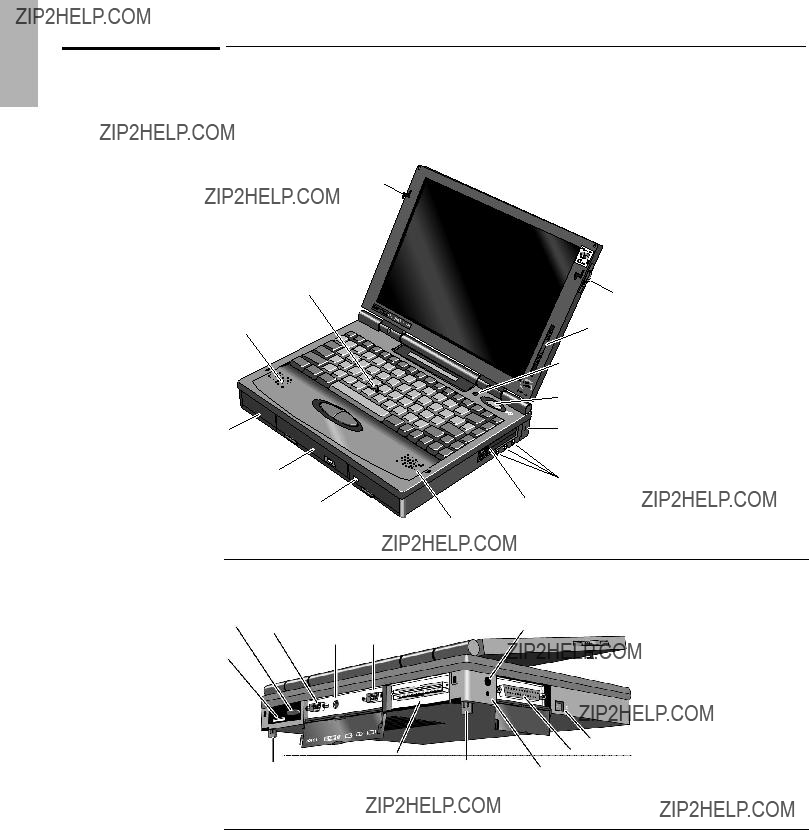
Starting Out with Your OmniBook
A tour of the OmniBook
A tour of the OmniBook
The following illustrations point out key parts of the OmniBook.
Latch to open OmniBook
TrackPoint III
Hard disk drive
Kensington lock slot
Audio jacks
PC card slots
Internal speaker

Starting Out with Your OmniBook
A tour of the OmniBook
To adjust the display
Brightness All OmniBooks are equipped with a brightness control. Some models also
have a contrast control. The display controls are located to the right of the display.
Contrast
To increase brightness or
contrast, slide the controls up.
To decrease, slide down.
To use the pointing device
The pointing device controls the motion of the pointer on the screen by detecting pressure. The pointing device itself does not move. The click buttons work like those on a standard
1.Place your hands in the typing position.
2.With your index finger, gently press the pointing device in the direction you want the pointer to move.
3.Click the buttons with your thumb to select and drag.
TrackPoint III
Click buttons

Starting Out with Your OmniBook
A tour of the OmniBook
To adjust the OmniBook keyboard
You can tilt the OmniBook keyboard to a more comfortable typing angle with the
Tilt foot
Special features of the OmniBook keyboard
In addition to the standard typing keys, the OmniBook keyboard contains the following special keys and features:
Fn combination keys
Use the gold Fn key in combination with other keys to execute special functions??? for example, Fn+F8 decreases the speaker volume. You press and hold the Fn key, then you press the other key.
Embedded numeric keypad
Press the Num Lock (number lock) key to use the numeric keypad. With the keypad active, keys change to the designations shown on their slanted faces.
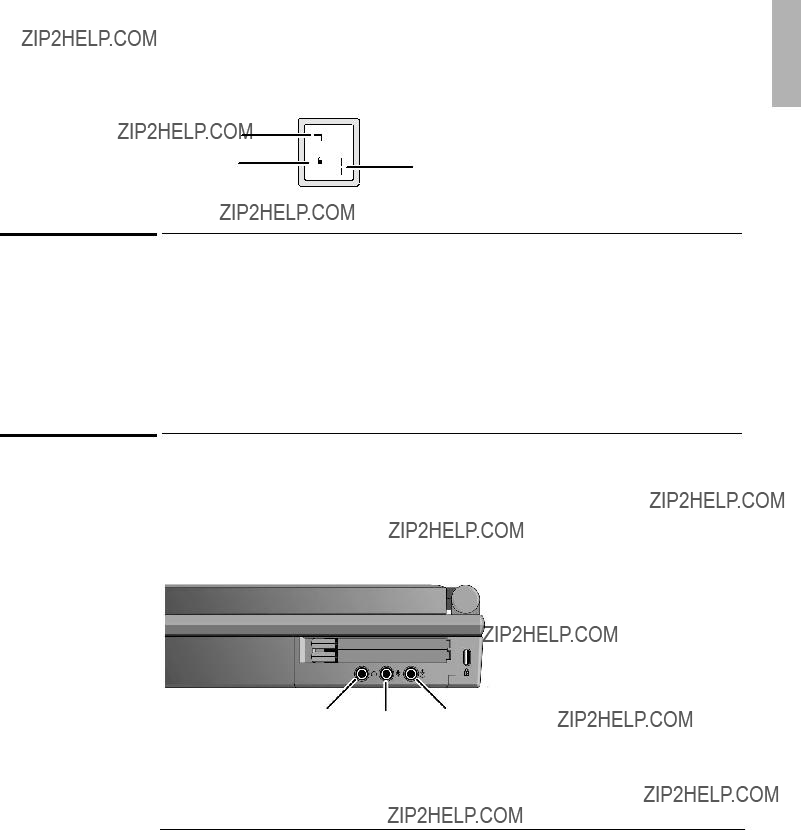
Starting Out with Your OmniBook
A tour of the OmniBook
Alt Gr key
If your keyboard has an Alt Gr key to the right of the spacebar, you hold that key to type the characters printed at the
To adjust the speaker volume
All OmniBook 2000/5700 models support Sound Blaster compatible sound. The easiest way to adjust the speaker volume is to use the built in Fn key combinations.
???Hold down Fn and press F8 or F9 as needed to gradually decrease or increase the maximum volume.
To connect a microphone, speakers, or headphones
Your OmniBook has a
Headphones Microphone Stereo input
When you plug in an external microphone, the

Starting Out with Your OmniBook
A tour of the OmniBook
To start the OmniBook
You can easily start and stop your OmniBook using the blue On/Suspend button. However, at certain times, you may want to use other methods for starting and stopping your
???Press the blue On/Suspend button. Either your previous session resumes or the computer reboots, depending on how you stopped the
If you want to know more about what happens when you stop the OmniBook, you can check the table on page
Suspend icon appears
in the status panel.
To stop the OmniBook
???Press the blue On/Suspend

C A U T I O N
C A U T I O N
Starting Out with Your OmniBook
A tour of the OmniBook
Press Fn+F12 simultaneously with the ac adapter unplugged. This stores the current session on the hard disk and completely shuts down the OmniBook. The computer reboots when you turn it on, then restores the session.
Shut down Windows, then press the square Off button on the left side of the case for 2 seconds. This deletes the current session and completely shuts down the OmniBook. The computer reboots when you turn it on and starts a new session.
Windows 95 can become unstable if you press the square Off button without properly shutting down Windows.
Off button
If you have active network connections, or if you have any SCSI devices connected, plug in the ac adapter and press the blue On/Suspend button to stop the OmniBook. These connections and devices are disconnected if you stop the OmniBook any other way.
Windows 95 can restore network connections and SCSI devices when you turn on the OmniBook. For a different operating system, you may have to reboot the OmniBook or restart the operating system to restore them.

Starting Out with Your OmniBook
A tour of the OmniBook
Effects of Stopping the OmniBook
Power States after Stopping the OmniBook
???
Windows 95 can restore network connections and SCSI devices when you turn on the OmniBook.

Starting Out with Your OmniBook
A tour of the OmniBook
For Windows 95, the Start button provides two commands that stop the OmniBook.
???Suspend changes the OmniBook to the Suspend state.
???Shut Down (shut down the computer) changes the OmniBook to the Off state.
If you plug in the ac adapter while the OmniBook is stopped,
In addition, Advanced Power Management (APM) provides several automatic
If the OmniBook is running on battery power and there???s no activity for a short period of time, it automatically stops by changing to the Suspend state.
If you leave the OmniBook stopped in the Suspend state for a long time without plugging in the ac adapter, it automatically saves power by changing to the Hibernate state. Your session is saved.

Hint
Starting Out with Your OmniBook
A tour of the OmniBook
To reset and restart the OmniBook
If your OmniBook stops
1.If possible, shut down Windows.
2.Press Ctrl+Alt+Del to reboot the OmniBook.
Press the square Off button on the left side of the case for 2 seconds, then press the blue On/Suspend button.
Insert a straightened paper clip into the small hole below the ac adapter socket and press the Reset button inside the hole.
Reset button
If you want to reboot from a boot disk in the floppy disk drive, put the disk in the floppy disk drive before you restart the OmniBook. For example, you can reboot from the Support Utility disk, then use the commands on this disk to check your hard disk.

Starting Out with Your OmniBook
A tour of the OmniBook
To understand the status panel
The OmniBook status panel, located above the keyboard, contains indicators that show the current status of the OmniBook. There are three groups of icons on the status panel that indicate
???Keyboard status.
???Data storage status.
???Power status.
Keyboard status
The icons on the right indicate Caps Lock, Num Lock, and Scroll Lock.
This icon appears when Caps Lock is active.
This icon appears when Num Lock is active.
This icon appears when Scroll Lock is active.
Data storage status
The center icons indicate data storage
This icon appears when the OmniBook is reading from the
This icon appears when the OmniBook is reading or writing to the floppy disk drive.
This icon appears when the OmniBook is reading or writing to drive C.
These icons appears when you insert PC cards into the card slots. Each icon identifies when a PCMCIA card slot is occupied.

Starting Out with Your OmniBook
A tour of the OmniBook
Power status
These icons indicate power
This icon appears when the OmniBook is in the Suspend power state; the ???bookmark??? icon reminds you that the state of the computer has been saved.
This icon appears when the ac adapter is plugged in.
The shading of the battery symbol shows the approximate charge level of the battery relative to a full charge.
The lightning bolt symbol appears when the battery is charging. The battery symbol blinks when the battery is low.
To attach a security cable
1.Wrap the cable around a stationary object, such as a table leg.
2.Loop the cable to create a slip knot around the stationary
3.Insert the lock into the OmniBook???s Kensington lock slot and release the key.
Store the key in a safe place away from the OmniBook.

Starting Out with Your OmniBook
Using OmniBook Accessories
Using OmniBook Accessories
Depending on the accessories you purchased with your OmniBook, the center
In this section you???ll learn how to
???Remove accessory modules from the OmniBook.
???Install and use the floppy disk drive.
???Install and use the
???Replace the main battery.
???Install a second,
???Handle and store the battery safely.
???Maintain and preserve battery life.
???Insert and remove a PC card.

Starting Out with Your OmniBook
Using OmniBook Accessories
To remove accessories from the OmniBook
The OmniBook???s center drive bay can hold a
Floppy disk drive
Use this procedure to remove any of these accessories.
1.Slide the switch to the right. A
2.Pull the
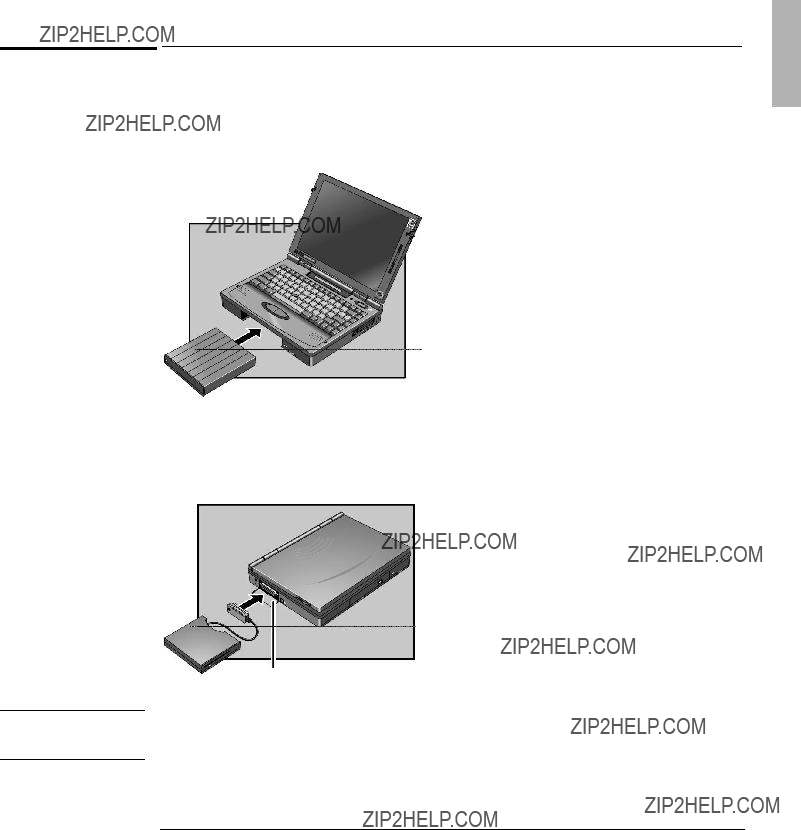
Important
Starting Out with Your OmniBook
Using OmniBook Accessories
To install the floppy disk drive
1.If necessary, remove the current accessory module from the OmniBook.
2.Slide the floppy disk drive into the OmniBook until it clicks into place.
Connect the floppy disk drive to the OmniBook externally by pulling out the floppy disk drive cable and connecting it to the parallel port on the left side of the OmniBook.
Parallel port
The external floppy disk drive works only with the OmniBook???s parallel port. It does not work with the parallel port on the docking system or port replicator.
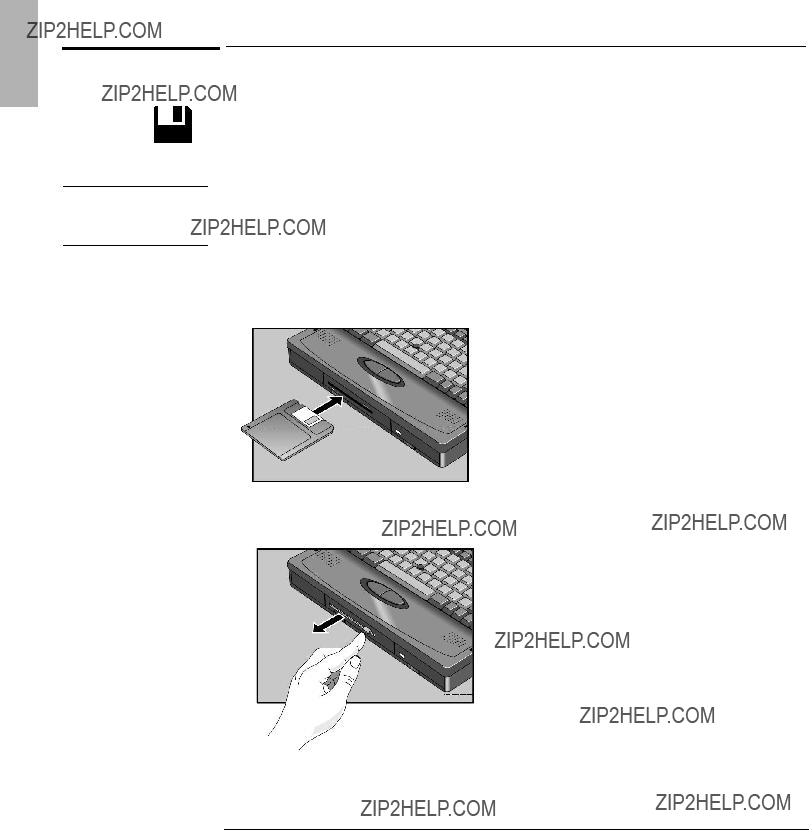
floppy disk indicator
C A U T I O N
Starting Out with Your OmniBook
Using OmniBook Accessories
To insert and eject a floppy disk
When the OmniBook is reading or writing data to the floppy disk drive, the floppy disk indicator appears on the Status Panel (above the function keys).
Do not insert or remove a floppy disk while the OmniBook is actively reading or writing data. Wait until the floppy disk drive stops reading or writing. Otherwise, you could lose data or the OmniBook could stop responding.
1.Hold the disk with its face up, then slide it into the floppy disk drive slot until it clicks into place.
2.To remove the floppy disk, press the eject button on the front of the floppy disk drive.
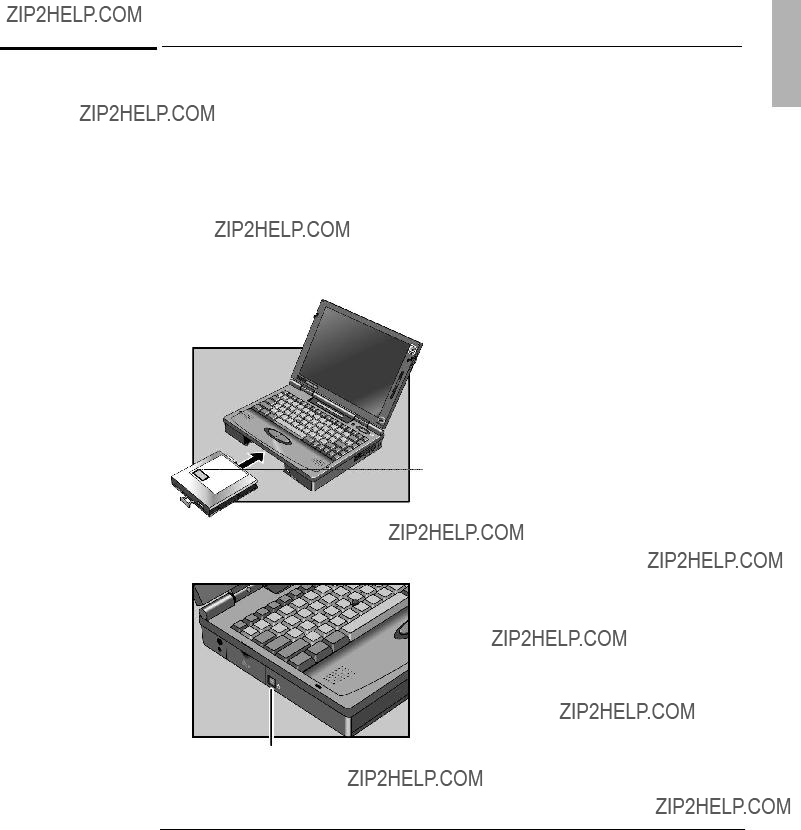
Starting Out with Your OmniBook
Using OmniBook Accessories
To install the
You install the
1.Important
Save your work and shut down
2.If necessary, remove the current accessory module from the OmniBook.
3.Slide the
4.Press the square Off button for 2 seconds, then press the blue On/Suspend button to restart the OmniBook.
Off button
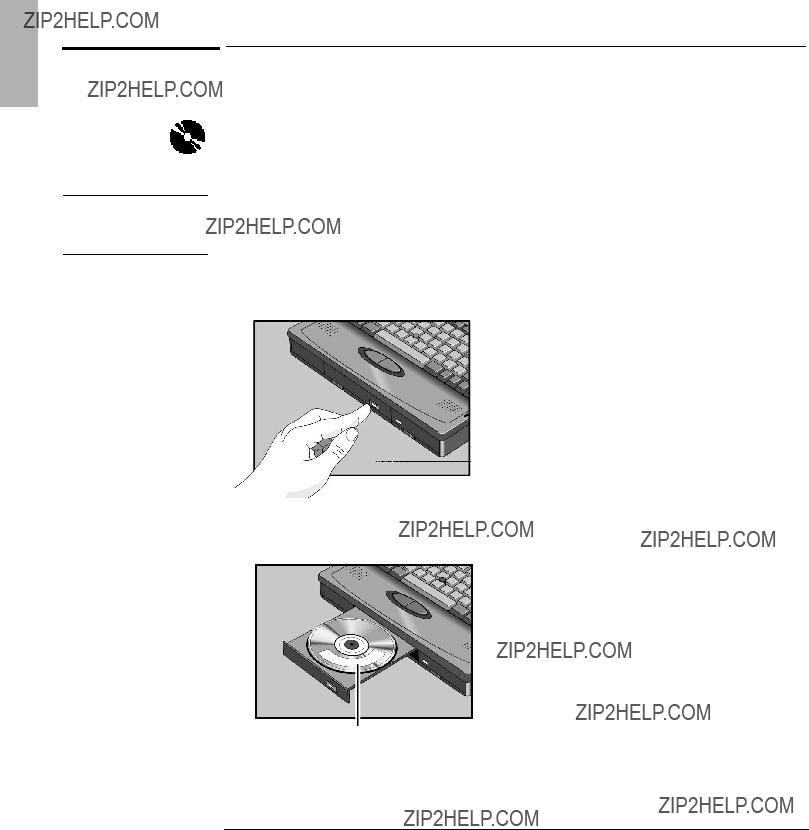
Starting Out with Your OmniBook
Using OmniBook Accessories
To insert and remove a CD
CD disk indicator
C A U T I O N
When the OmniBook is reading data from the
Do not insert or remove a CD while the OmniBook is actively reading data. Wait until the CD
1. Press the open button on the front of the
2.Place the CD in the drive and gently press down to seat it on the spindle.
Do not touch the
Label up
3.Close the door to the drive.
4.To remove the CD, press the open button on the front of the

Starting Out with Your OmniBook
Using OmniBook Accessories
To use the
The
???Ensure proper use by reading and following the instructions carefully.
???If the unit requires service, contact an authorized HP service
???Do not attempt to make any adjustment of the unit.
???Avoid direct exposure to the laser
CLASS 1 LASER PRODUCT
LASER KLASSE 1

Starting Out with Your OmniBook
Using OmniBook Accessories
To preserve your current work session, the OmniBook automatically turns off when the battery charge gets too
1.Important
Save your work. Then press the blue On/Suspend button to stop the OmniBook.
2.If available, plug in the OmniBook???s ac adapter.
3.Slide the battery switch to the right and slide the battery out of its compartment.
Slide switch to release battery.
4. Slide the new battery all the way into the battery compartment.

Starting Out with Your OmniBook
Using OmniBook Accessories
To install a
To increase the time you can work on battery power, you can install a second,
1.Important
Save your work. Then press the blue On/Suspend button to stop the OmniBook.
2.If necessary, remove the current accessory module from the OmniBook.
3.Slide the
A second Battery Status icon appears in the LCD status panel, showing the
approximate charge level of the new battery.

Protect battery life
Starting Out with Your OmniBook
Using OmniBook Accessories
To handle and store the battery safely
To safely use the battery, follow these instructions:
???To avoid risk of fire, burns, or damage to your battery pack, do not allow a metal object to touch across the battery contacts.
???The battery pack is suitable for use only with compatible OmniBook models and specified battery charger. Check the Support and Service booklet for your local HP contact.
???Do not disassemble. There are no serviceable parts inside. Do not dispose of the battery pack in fire or water.
???Handle a damaged or leaking
???Do not expose the battery pack to high storage temperatures (above 60 ??C, 140 ??F).
???When the battery is not in use, store it in the battery pouch provided.
???When discarding a battery pack, contact your local waste disposal provider regarding local restrictions on the disposal or recycling of batteries.
???To obtain a replacement battery, contact your local dealer or HP sales office.
???Do not charge the battery pack if the ambient temperature exceeds 45 ??C (113 ??F).
To maintain and preserve battery life
To preserve the life of your battery, be sure to charge the battery pack regularly. If a
battery pack is not used, it has limited
battery pack has the following

Starting Out with Your OmniBook
Using OmniBook Accessories
C A U T I O N
PC card indicator
To insert a PC card
The OmniBook PC card slots are available for storing data and expanding the communication capabilities of the OmniBook. The OmniBook supports standard Type I, II, and III PC cards (PCMCIA and CardBus). You can use two thin cards or one thick card. The lower card slot supports Zoomed Video, which allows a zoomed video card to show
Do not install Card Services or Socket Services software if it comes with your PC card. The OmniBook already includes Card Services and Socket Services, which automatically detect and set up PC cards you install in the upper and lower card slots. Different versions of this software will disrupt this support.
Never insert or remove a plug
The OmniBook automatically detects and sets up a card when you insert it in a card slot. See the card???s instructions for additional information.
1.Hold the card with its face up and its connector holes toward the card slot, then slide it into a PC card slot until it won???t go any further.
2.When the card is fully inserted, the PC card indicator appears on the Status Panel. A double beep signals that the card has been recognized and is
3.Inserting a card causes the slot???s button to protrude from the case. You can rotate the button towards the front to make it flush with the case.
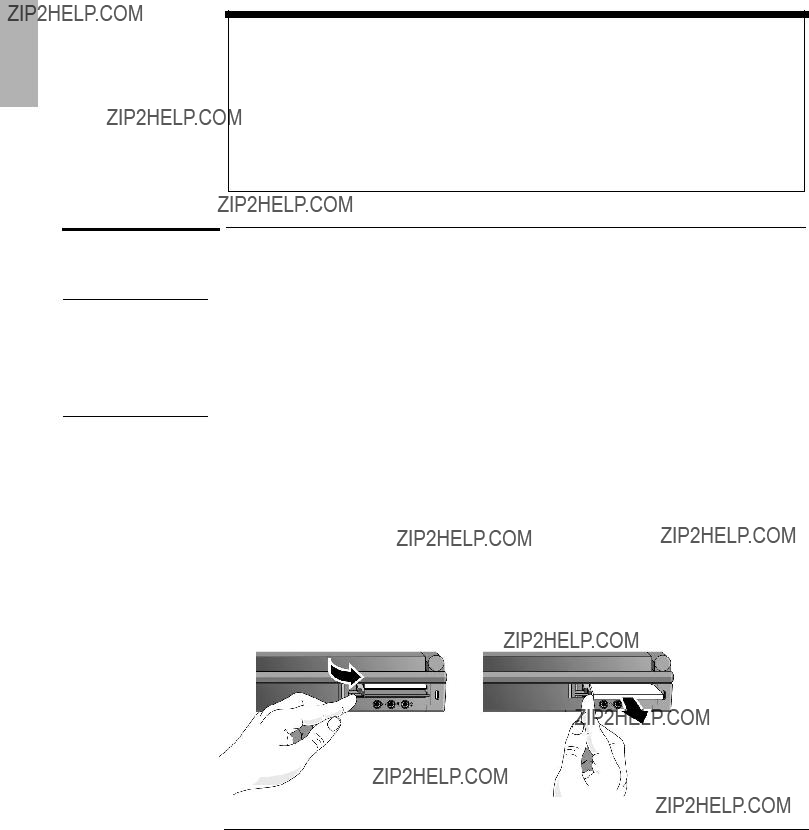
C A U T I O N
Starting Out with Your OmniBook
Using OmniBook Accessories
About RAM Cards
If you???re using a RAM card with the OmniBook, keep these suggestions in mind:
???For a new RAM card, install its battery before you insert the card.
???Replace the RAM card battery yearly.
When you want to replace a RAM card battery, plug the card into the OmniBook and make sure the OmniBook stays turned on while you replace the battery. You can plug in the ac adapter to keep it from turning off. Otherwise, the data on the card will be lost.
To remove a PC card
Never remove an I/O card while an application is open that???s set up to use that card. Exit the application first. If you remove the card, the application (or the OmniBook) might behave unpredictably or stop responding until you restart
the OmniBook. Never insert or remove a plug
Otherwise, you could lose data or the OmniBook could stop responding.
1.If you???re using Windows 95
Click the PC card indicator in the taskbar, then click Stop. This protects your data and avoids unexpected problems. You can restart the card by removing it, then inserting again
If you???re using Windows for Workgroups Go to step 2.
2.If necessary, rotate the ejector button so that it protrudes from the case.
3.Press the black ejector button until the card pops out, then pull out the card.

Starting Out with Your OmniBook
Where to Go from Here
Where to Go from Here
You can probably start using your OmniBook immediately, especially if you???re familiar with personal computers, or if you???ve already worked with Microsoft Windows. Still, your OmniBook is designed as a compact, mobile
See the Online Documentation
For detailed information about the OmniBook, see the online User???s Guide. Also see the other online information in the online OmniBook Library.
Check OmniBook Notes
For
Visit Our Web site
For updates to the BIOS and other technical information, connect to our
See the Corporate Evaluator???s Guide at our Website for complete information about installing alternate operating systems, as well as how to configure the OmniBook in a corporate, networked environment.

2
Installing an Operating System

Installing an Operating System
This chapter has instructions for installing or recovering an operating system. Your
OmniBook package includes a Recovery CD, the (FAT16) Support Utility floppy disk,
and the Microsoft Windows 95 Companion CD. With these tools , you can install or
recover
???Windows 95 operating system.
???Windows for Workgroups from your own disks.
???Other HP programs, online User???s Guide, and drivers from the Recovery CD that came with your OmniBook.
???Windows NT and OS/2 Warp from your own disks, and using instructions and drivers from the Corporate Evaluator???s Guide on our Website at http://www.hp.com/go/omnibook. In addition, this site contains the latest updates of software drivers, and information on configuring the OmniBook in a corporate, networked environment.

Installing an Operating System
What the Recovery CD Contains
What the Recovery CD Contains
You will need the Recovery
The following sections tell you how to set up and start a recovery installation. Refer
to the README text file on the Recovery CD and the Support Utilities disk for

Installing an Operating System
Reinstalling Windows 95
Reinstalling Windows 95
The following procedure describes how to reinstall the Windows 95 operating system that came with your OmniBook. These steps will format the hard drive. Back up any files you would like to save before reinstalling Windows 95.
The entire recovery process takes approximately 1 hour. To recover your Windows 95 operating system, you???ll need a
To reinstall Windows 95
1.If you have an internal CD
If you have a SCSI CD
If you have a PC card or Parallel Port CD
2.Connect the ac adapter to the OmniBook.
3.Insert the Recovery CD in the
4.Insert the Support Utility disk in the floppy disk drive.
5.Reset the OmniBook.
The DOS 6.22 Startup menu appears.
6.Click option 2:
Recover Windows 95 from OmniBook Recovery CD
7.Click the type of
8.Follow the setup instructions on the screen.

Installing an Operating System
Reinstalling Windows 95
9.When prompted for ???Hibernate??? partition size, you can continue with the default 64M byte Hibernate partition or choose an alternate size (based on the amount of system RAM installed).
10.After the successful creation of the Hibernate partition , press Ctrl+Alt+Del to reboot the OmniBook.
The DOS 6.22 Startup menu appears.
11.Click option 2:
Recover Windows 95 from OmniBook Recovery CD
12.Click the type of
The recovery process continues. This can take up to an hour. Do not interrupt the recovery process or unplug the ac adapter until recovery is completed.

Installing an Operating System
Reinstalling Windows for Workgroups
Reinstalling Windows for Workgroups
The following procedure describes how to restore Windows for Workgroups and your original OmniBook software.
The entire recovery process takes approximately 1 hour. To recover your Windows for Workgroups operating system, you???ll need a
Recovery CD, and the Support Utility disk. If you don???t have backup disks, you can make
To reinstall Windows for Workgroups
1.If you have an internal CD
If you have a SCSI CD
If you have a PC card or parallel port CD
2.Connect the ac adapter to the OmniBook.
3.Insert the Support Utility floppy disk.
4.Reset the OmniBook.
The DOS 6.22 Startup menu appears.
5.Click option 4:
Create Hibernate Partition (erases Hard Disk)
6.When prompted for ???Hibernate??? partition size, you can continue with the default 64M byte Hibernate partition or choose an alternate size based on the amount of system RAM installed.

Installing an Operating System
Reinstalling Windows for Workgroups
7.After the successful creation of the Hibernate partition, insert
8.Follow the setup instructions on the screen.
9.When prompted for installation choices, click the defaults.
10.When the
A:.This is the
11.Type SETUP C:\DOS to install the
12.Install Windows for Workgroups (from
???Insert disk #1 and type A:\SETUP.
???Click Express Setup.
???Select all defaults for this installation. Do not install any printers or networks. Install them after the rest of this installation is complete.
13.Insert the Recovery CD in the
14.Insert the Support Utility disk in the floppy disk drive.
15.Reset the OmniBook. The DOS 6.22 Startup menu appears.
16.Click option 3:
Recover Windows for Workgroups drivers and HP Application Software
17.Click the type of
Do not interrupt the recovery process or unplug the ac adapter until recovery is completed.
To make DOS 6.22 and Windows for Workgroups disks
When you set up the Windows for Workgroups operating system, you should have been prompted to create a set of backup disks for Windows for Workgroups and DOS 6.22. If you did not make backup disks, you can do so now with the following procedure.
1.From the OmniBook group,
2.Follow the setup instructions on the screen.

Note
Installing an Operating System
Reinstalling Windows for Workgroups
To install Windows for Workgroups drivers
If you've installed a commercial version of Windows or Windows for Workgroups, you'll need to manually install the required OmniBook device drivers or use the OmniBook 2000/5700 Windows 3.X Driver Setup program. These steps modify some of your system
1.If you have an internal CD
If you have a SCSI CD
If you have a PC card or parallel port CD
2.Connect the ac adapter to the OmniBook.
3.Insert the Support Utility floppy disk.
4.Reset the OmniBook. The DOS 6.22 Startup menu appears.
5.Click option 5: Exit to MS
6.Insert the Recovery CD in the
7.From the DOS prompt, type C:\WINDOWS\WIN to start Windows.
The path may need to be adjusted if Windows was installed in a location other than the default.
8.From File Manager, go to the
9.
10.Choose Next to install the drivers, then follow the setup instructions.

C A U T I O N
Installing an Operating System
Installing Windows NT or OS/2 Warp
Installing Windows NT or OS/2 Warp
You provide the software to install these alternate operating systems. See the
Corporate Evaluator???s Guide at our Website for complete information on installing these operating systems, as well as how to configure the OmniBook in a corporate, networked environment.
To install Windows NT or OS/2 Warp
You will need
???On the Recovery CD ROM, under OMNIBOOK\DRIVERS.
???On the OmniBook's hard drive under C:\OMNIBOOK\DRIVERS.
??? On our Website at http://www.hp.com/go/omnibook . This site contains the latest updates of software drivers.
Different versions of an operating system require different drivers, so make sure to select the appropriate driver
The equipment you need are the OmniBook, its ac adapter, a floppy disk drive, and a
Before you start installing a new operating system, make sure the drivers you

Installing an Operating System
Installing HP Applications
Installing HP Applications
If you have deleted the online User's Guide, OmniBook Tools, or any of the Personal Information Management applications, you can reinstall them from the Recovery CD.
To install HP software programs
1.If you have an internal CD
If you have a SCSI CD
If you have a PC card or parallel port CD
2.Insert the Recovery CD in the
From the \OMNIBOOK\HPUTILS\DISK1 directory on the CD,
3.Click the HP applications you???d like to install, then click Install Now.

3
Expanding the OmniBook

Expanding the OmniBook
This chapter describes procedures to expand or update the capabilities of your OmniBook, including:
???Replacing internal hardware.
???Connecting external devices.

Expanding the OmniBook
Replacing Hardware
Replacing Hardware
This section describes how to
???Remove and install the hard disk drive.
???Find the system software version and memory size.
???Install a
To remove the hard disk drive
You can upgrade the OmniBook system by installing a new hard drive or you may want to switch hard drives between OmniBooks.
1.Important
Back up all the files on your current drive C. You can back up the files to a tape drive, a network drive, a PC card, or a flexible disk.
2.Unplug the adapter.
3.Exit Windows.
???If you???re using Windows 95, use the shutdown option from the Start menu.
???If you???re using Windows for Workgroups, exit Windows, then press the Off button.
4.Remove all batteries from the OmniBook.
5.Close the cover and turn your computer over.
6.Remove the screw and security cover located at the back of the hard disk drive.
7.Firmly slide the drive out of the drive compartment. (This requires some force.)

Expanding the OmniBook
Replacing Hardware
To install the hard disk drive
After following the previous instructions for removing the hard disk drive, use these
steps to install the new hard drive.
1.Gently press downwards on the hard drive while you slide it into the drive bay.
2.Make sure the drive is fully inserted.
It may be necessary to use a small pair of pliers to pull up on the
3.Replace the screw and security cover.
4.Replace the battery or attach ac power.
5.Press the Off button for 2 seconds, then press the blue On/Suspend button.
To find the system software version and memory size
In Windows 95
???Click Start, HP User Tools, Information 2, OmniBook System Information. The software version and amount of memory are displayed.
In Windows for Workgroups
1.In Program Manager,
2.In the window???s Control menu, click About. The software version and amount of memory are displayed.

C A U T I O N
Expanding the OmniBook
Replacing Hardware
To add memory to the OmniBook
The OmniBook memory slots accommodate two
Take precautions against damage from static electricity: Gather all the parts you need so you can complete the installation in one sitting. Don???t remove the memory
memory
1.Exit
???If you???re using Windows 95, use the shutdown option from the Start menu.
???If you???re using Windows for Workgroups, exit Windows, then press the square Off button.
2.Unplug the adapter and remove all batteries from the OmniBook.
3.Use a
4.If a
5.Position the
6.Replace the slot cover.
7.Insert the battery, then press the blue On/Suspend button.
8.When you see the following message:
WARNING - UNEXPECTED AMOUNT OF MEMORY - RUN SCU press F2 to go to the System Configuration Utility.
9.Press Alt+X to open the SCU Exit menu.
10.Click Save and Exit to update the system configuration.

Expanding the OmniBook
Replacing Hardware
If you???re using Windows for Workgroups
11.In Control Panel,
12.If the Use
13.Click OK to save the new setting. When prompted, click Restart Windows to activate the new setting.

Expanding the OmniBook
Connecting Devices
Connecting Devices
Your OmniBook is a powerful computer in its own
???Connect an external monitor and adjust the display type.
???Turn off the
???Connect and install a printer.
???Connect an external mouse and keyboard.
???Enable Fn keys on an external keyboard.
???Connect a serial device.
???View or change serial port assignments.
???Connect a parallel device.
???View or change parallel port assignments.
???Make an infrared connection and print on an infrared printer.
???Set up a PC card or parallel port
???Connect a MIDI device or joystick.

Expanding the OmniBook
Connecting Devices
To connect an external monitor
You can connect a VGA, SVGA, or XGA monitor to your OmniBook. When you connect the external display, the OmniBook automatically recognizes and activates it. The
1.Make sure the external monitor supports VGA, super VGA, or XGA format.
2.Plug the cable from the external display into the
To adjust the display type
The default display setting provides optimum performance for the OmniBook???s
internal display. To change the display options for the external monitor
???in Windows
???in Windows for
If the external display has higher resolution than the OmniBook display, you???ll have to turn off the OmniBook display to see the higher resolution.
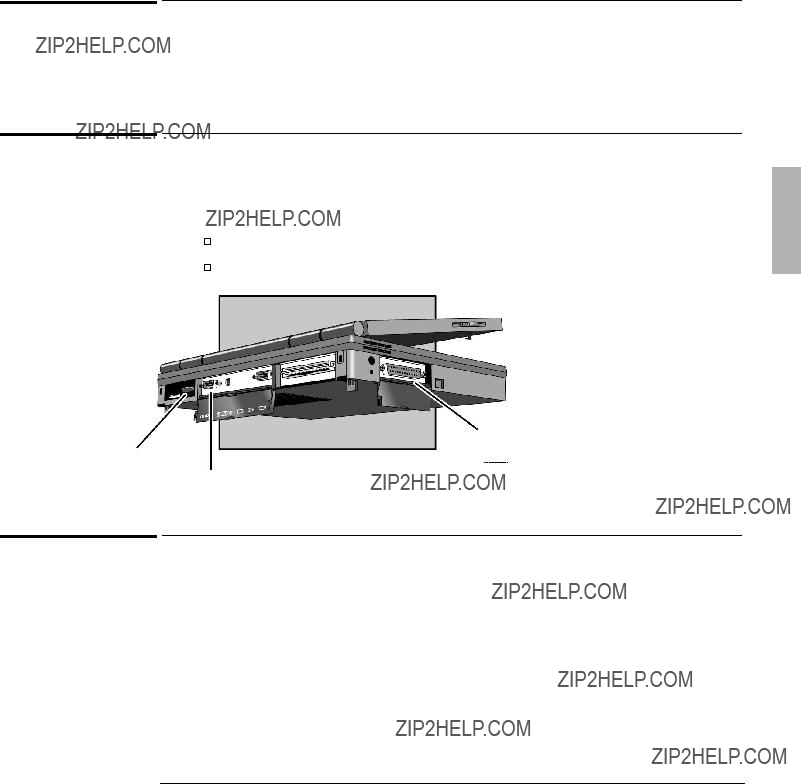
Expanding the OmniBook
Connecting Devices
To turn off the
??? Press Fn+F5 to switch between the external and
To connect a printer
??? Plug the printer cable into the appropriate port at the back of the OmniBook.
A parallel printer is normally at the LPT1 port.
A serial printer is normally at the COM1 port.
Parallel port
Infrared port
Serial port
To install a printer
Before you can print from your OmniBook, you have to install the printer so that it can communicate with the OmniBook.
???In Windows
???In Windows for

Expanding the OmniBook
Connecting Devices
To connect an external mouse or keyboard
Although the OmniBook comes with a
1.Plug the mouse or keyboard cable into the external mouse/keyboard port on the back of the OmniBook.
If you attach an external
mouse, you cannot use
the
pointing device.
2. Turn the OmniBook off and on again with the blue On/Suspend button.
To connect both a mouse and keyboard
1.Purchase a standard
2.Plug the
3.Connect the external mouse and keyboard to the
Mouse
Keyboard

Expanding the OmniBook
Connecting Devices
To enable the Fn keys
If you???ve connected an external keyboard, you need to enable the external Fn keys.
1.Press Fn+F2 to start the SCU.
2.From the Input/Output menu, select External Devices.
3.Check Enable External Fn Key.
To access the Fn key on your external keyboard, use Ctrl+Alt. For example, to access Fn+F2, press Ctrl+Alt+F2.
To connect a serial device
The OmniBook
To view or change serial port assignments
You can see and change the serial communications port names (COM1, COM2, COM3, and COM4) assigned to the serial port and infrared port.
1.Save any open
2.Press Fn+F2 to enter the System Configuration utility.
3.Use the Input/Output menu COM Ports command to change the COM names for the serial port and the physical infrared port (normally COM1 and COM2). PCMCIA
4.Exit the utility without
5.If you changed the port assignments, you must reboot the OmniBook to make the new assignments active.

Expanding the OmniBook
Connecting Devices
To specify serial port settings
Many applications provide a way for you to adjust the settings for serial ports they use. Other applications don???t let you change serial port settings. However, you can use Control Panel to set the basic serial port
In Windows 95
1.From Control Panel,
2.Click the Device Manager tab to see a list of serial (COM) ports.
3.To view the settings for a COM port, select the port and click Properties. (The serial port is normally COM1, and the physical infrared port is normally COM2.)
In Windows for Workgroups
???Open Control Panel and
Hardware Settings
The changes you make to the advanced settings for a serial port should match your hardware settings. The
???COM1: address 3F8 hex, interrupt 4.
???COM2: address 2F8 hex, interrupt 3.
???COM3: address 3E8 hex, interrupt 4.
???COM4: address 2E8 hex, interrupt 3.

Expanding the OmniBook
Connecting Devices
To connect a parallel device
The OmniBook
???For a printer connection, use a standard parallel printer cable available at computer dealers or electronic supply stores.
???For any other connection, such as a
To view or change parallel port assignments
You can see and change the parallel port names (LPT1, LPT2, LPT3) assigned to the
printer port.
1.Save any open
2.Press Fn+F2 to enter the System Configuration utility.
3.From the Input/Output menu, click LPT Port.
4.Select the new port assignment and click OK.
5.From the Exit menu, click Save and Reboot.
If you???re prompted, enter your password, then click OK.
6.Click OK to reboot your OmniBook. The parallel addresses are as follows:
???LPT1: address 378 hex.
???LPT2: address 278 hex.
???LPT3: address 3BC hex.

Expanding the OmniBook
Connecting Devices
To make an infrared connection
The infrared port provides a type of serial connection that doesn???t require cables??? you just have to line up the device???s infrared port with the right rear of your OmniBook.
Keep the distance within about 3 feet (1 meter) for optimum performance. For example, you can establish a connection to an infrared printer by simply aiming the back of the OmniBook at the printer.
To print on an infrared printer
To connect to an infrared
In Windows 95
??? Click Start, Infrared. Use the tabs in the infrared window to set options.
You can disable infrared printing by unchecking the Enable infrared communication box in the Options tab.
In Windows for Workgroups
1.From Program Manager,
2.Click Connections, then Infrared Communications.
3.Select the options you want:
???You can enable infrared printing immediately.
???You can enable infrared printing every time you start Windows.
???You can disable infrared printing by clearing options.
For more information about IrMonitor, see its online help.

Hint
Expanding the OmniBook
Connecting Devices
To set up a PC card or parallel port
The general steps for setting up a PC card
1.Copy the device
2.Add the device=driver statements to the CONFIG.SYS file on the Support Utility disk. The device statements should immediately follow the [USERCD] label.
3.Check the AUTOEXEC.BAT file to make sure that the
Before the OmniBook can recognize the
What you???ll need from your
1.The names of the device drivers to copy to the Support Utility disk.
2.The device=drivers statements to add the CONFIG.SYS file.
3.Statements that the
Both the CONFIG.SYS and AUTOEXEC.BAT files contain comments that should help your

4
Changing the Configuration

Changing the Configuration
This chapter describes the OmniBook tools and utilities that come with the OmniBook. Use them to view and adjust configuration settings.
This chapter describes
???HP User Tools (Windows 95 operating system only).
???OmniBook Tools (Windows for Workgroups operating systems only).
???System Configuration Utility

Changing the Configuration
Changing the Configuration
Changing the Configuration
For any operating system, you can use the System Configuration Utility (SCU) to change OmniBook configuration settings. For Windows 95 and Windows for Workgroups, you can also use a Tools application in Windows. The SCU provides more options for certain settings. The following chart summarizes the OmniBook settings. See the sections of this chapter for details.

Changing the Configuration
Using HP User Tools
Using HP User Tools
HP User Tools give you a convenient way in Windows 95 to change the way your
OmniBook looks and operates. For many settings, it???s an alternative to using the
System Configuration Utility.
To run HP User Tools
1.Click Start, HP User Tools.
2.Click the tabs and buttons for the changes you want to make. You???re prompted if you need to reboot the computer. Click Help or see the table below for more information.
3.After you make the changes, exit HP User Tools.

Changing the Configuration
Using HP User Tools

Changing the Configuration
Using OmniBook Tools
Using OmniBook Tools
OmniBook Tools give you a convenient way in Windows for Workgroups to change the way your OmniBook looks and operates. For many settings, it???s an alternative to using the System Configuration Utility.
To run OmniBook Tools
1. In Program Manager,

Changing the Configuration
Using OmniBook Tools

Changing the Configuration
Using the System Configuration Utility
Using the System Configuration Utility
The System Configuration Utility (SCU) provides access to basic configuration
settings. It is independent of the operating system.
To run the SCU (during reboot)
1.Close all applications, then shut down Windows and reboot the OmniBook. If necessary, you can press Ctrl+Alt+Del to reboot.
2.During reboot, at the message ???<F2> to enter System Configuration Utility,??? press F2 to start the SCU.
3.The mouse is not active in the SCU. Press Alt to activate menus, and use the Tab key, arrow keys, spacebar, ENTER, and ESC to navigate and change settings. See the tables below for more information.
4.After you select the options you want, use the Exit menu to close the SCU.
5.Certain settings require that you reboot the OmniBook before they take effect. We recommend rebooting after changing SCU settings.
To run the SCU without rebooting
This method is not supported by certain operating systems, such as OS/2.
1.Save your data in any open applications.
2.Press Fn+F2 simultaneously to start the SCU.
3.The mouse is not active in the SCU. Press Alt to activate menus, and use arrow keys, spacebar, ENTER, and ESC to navigate and change settings. See the tables below for more information.
4.After you select the options you want, use the Exit menu to close the SCU. Certain settings require that you reboot the OmniBook before they take effect.
The following table describes the action required when changing SCU options:

Changing the Configuration
Using the System Configuration Utility

Changing the Configuration
Using the System Configuration Utility

Changing the Configuration
Using the System Configuration Utility

5
Troubleshooting

Troubleshooting
If you have questions that this manual doesn???t answer, you can
???See the online OmniBook User???s
???If you???re using Windows for Workgroups, check the online Windows Quick Start and
???If you???re using Windows 95, check the printed Introducing Microsoft Windows manual.
???Look at the online Help for Windows and other applications.
???Check with your computer system administrator, if you have one.
???See other books about Windows,
???Contact your dealer, or contact
???Get information about system resources (interrupts, addresses, and memory)??? see ???Software System Resources??? on page
???Find technical information about the OmniBook on the

Troubleshooting
Solving Basic Problems
Solving Basic Problems
If your OmniBook has a problem starting, find the symptom below that matches
your situation. Try the suggestions one at a time.
If the OmniBook turns off immediately after it turns on
???Battery power is probably extremely low. Plug in the ac adapter, or insert a charged battery pack.
If the OmniBook stops responding
???Press the blue On/Suspend button and wait a few moments until the icons on the status panel stabilize. Then press the blue button again to turn the OmniBook back on.
If necessary, press Ctrl+Alt+Del to reboot.
???If nothing happens, insert a paper clip or other slender object into the reset slot on the left side of the case, below the ac adapter socket. Push in momentarily??? the system should reset and reboot.
If the OmniBook doesn???t respond at
???Connect the ac adapter.
???Press On/Suspend to try turning on the unit.
???Insert a insert a paper clip or other slender object into the reset slot in the left side of the case, below the ac adapter socket. Push in
If you get no response, remove the battery and ac adapter and reset the OmniBook
If the cursor sometimes drifts on the screen
The TrackPoint is constantly being calibrated and sometimes the cursor drifts during the process. If this occurs, remove your finger from the TrackPoint for 3 seconds to allow proper calibration.

Troubleshooting
Solving Basic Problems
If the OmniBook doesn???t reboot successfully
If your operating system is
???If no text is displayed, or if things stop before you see any text about
???If you see error messages during startup, but Windows starts or you get an
???If you see text about
If it reboots, type dir c: to see if drive C contains valid files. Then try the following:
If drive C has valid files, try typing these commands:
scandisk c: (to repair any defects)
sys a: c: (to restore core
Last resort: The following commands delete all files on drive C, so you must reinstall your files after running these commands:
fdisk (to reinitialize drive C)
format c: /u (to prepare drive C for storing data)
If it still doesn???t start, try reinstalling the Windows for Workgroups files on drive
If your operating system is Windows 95
???If no text is displayed during reboot, or if things stop before you see ???Starting Windows 95...???, the unit probably requires service.
???If you see ???Starting Windows 95...??? during startup followed by error messages, reboot
Use the ???safe mode??? option to start Windows with a basic configuration. Run ScanDisk (in System Tools) to fix problems with drive C. You can also make other changes to repair your startup files.

Troubleshooting
Solving Basic Problems
Use the
???If drive C (the hard disk) isn???t working properly, insert the Support Utility floppy disk in the floppy disk drive, then press Ctrl+Alt+Del to reboot from drive A??? then click the Minimum Startup option. At the
If your system password doesn???t work
???Check whether Num Lock is off. Try changing it.
???If you???ve forgotten your password, have your OmniBook at hand and call
If the screen is difficult to read
???Set the display resolution to its original
???Try adjusting the display controls below or to the right of the screen.
???Try changing the color scheme. For Windows for Workgroups, use Display in OmniBook Tools. For Windows 95, use Display in HP User Tools.

6
Specifications and Regulatory
Information

Specifications and Regulatory Information
Your OmniBook is designed to provide
suggestions can help you maintain its dependability:
???Observe the temperature limits and other specifications listed in the next section.
???Check out the tips about ergonomics and work habits.
???If you have problems, see the
???If you think your OmniBook might need repair service, see the warranty and service information in the Support and Service booklet.
To contact Hewlett
Support and Service booklet or in OmniBook Support in the online OmniBook Library. Please have your OmniBook with you.
To clean the OmniBook: You can clean the OmniBook with a soft cloth dampened either in clean water or in water containing a mild detergent. Do not use an excessively wet cloth nor allow water inside the case. Do not use any abrasive cleaners, especially on the display. Do not apply any cleaner directly to the display.
Instead, apply the cleaner to a soft cloth and then gently wipe the display. You can clean the keyboard with a vacuum cleaner to remove accumulated dust.

Specifications and Regulatory Information
Hardware Specifications
Hardware Specifications

Specifications and Regulatory Information
Software System Resources
Software System Resources
Below are default values for the system resources. To see other,
System Resources
The tables in this section show typical resource usage as set up by the OmniBook BIOS.
System Interrupts
System Memory
Valid uses for memory addresses
???Upper memory blocks (UMBs) in the range
???PC card and ISA/PCI card memory windows in the range
???ISA/PCI card boot ROM in the range

Specifications and Regulatory Information
Software System Resources
System Input/Output Addresses (100
DMA Channels
0Sound record
1Sound playback
2Floppy disk drive
3Fast IR
4DMA controller
5Free
6Free
7Free

Specifications and Regulatory Information
Safety Information
Safety Information
Power Cord, Plug, and Voltage Requirements
The power cord supplied with the OmniBook ac adapter should match the plug and voltage requirements for your local area. Regulatory approval for the ac adapter has been obtained using the power cord for the local area. However, if you travel to a different area and need to connect to a different outlet or voltage, you should use one of the power cords listed below. To purchase a power cord (including one for a country not listed below) or a replacement ac adapter (HP part number F1044B), contact your local
Power Cords

Specifications and Regulatory Information
Safety Information
Battery Safety
???To avoid risk of fire, burns, or damage to your battery pack, do not allow a metal object to touch across the battery contacts.
???The battery pack is suitable for use only with an HP OmniBook 2000/5700 and F1338A battery charger.
???Do not disassemble. There are no serviceable parts inside.
???Do not dispose of the battery pack in fire or water.
???Handle a damaged or leaking
???Do not expose the battery pack to high storage
???When the battery is not in use, store it in the battery pouch provided.
???When discarding a battery pack, contact your local waste disposal provider regarding local restrictions on the disposal or recycling of batteries.
???To obtain a replacement battery, contact your local dealer or HP sales office.
???Do not charge the battery pack if the ambient temperature exceeds 45 ??C (113 ??F).

Specifications and Regulatory Information
Safety Information
Laser Safety
The
???Ensure proper use by reading and following the instructions carefully.
???If the unit requires service, contact an authorized HP service
???Do not attempt to make any adjustment of the unit.
???Avoid direct exposure to the laser
CLASS 1 LASER PRODUCT
LASER KLASSE 1
LED Safety
The infrared port located on the back panel of the OmniBook is classified as a Class 1 LED
???If the unit requires service, contact an authorized HP service
???Do not attempt to make any adjustment of the unit.
???Avoid direct eye exposure to the infrared LED beam. Be aware that the beam is invisible light and cannot be seen.
???Do not attempt to view the infrared LED beam with any type of optical device.
CLASS 1 LED PRODUCT
LEDSCH??TZKLASSE 1 PRODUKT
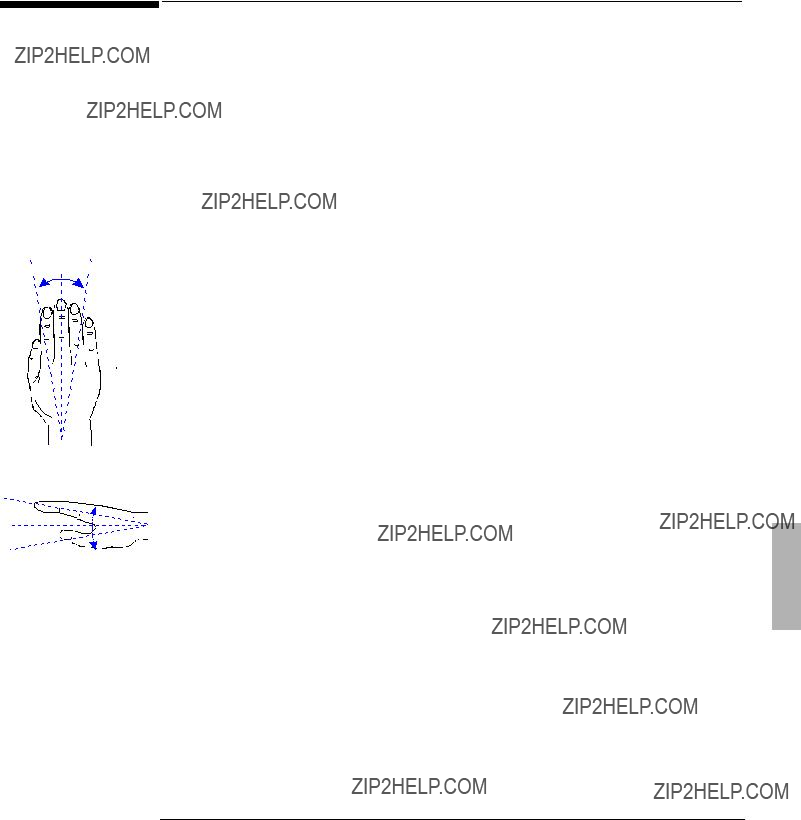
Specifications and Regulatory Information
Working in Comfort
Working in Comfort
Ergonomics is the science that fits products to people. Its goal is to make products easy, enjoyable, safe, and efficient to use. However, with even the best designed equipment, how you use the product is very important.
You can use your OmniBook virtually anywhere, anytime, so following the guidelines below can be a
???Place your OmniBook directly in front of you, within easy reaching distance for your hands when your arms are hanging straight down at your side (this is
 10?? 10??
10?? 10??
about 16 inches, or 40 centimeters, in most cases).
10??
10??
??? Whenever possible, adjust your seat height, work surface, or both to position the surface at approximately elbow height.
??? Try not to use a lot of force when
??? Do not rest your wrists on a sharp edge when typing. Whenever possible, find a work surface edge that is rounded or padded, or position yourself so your hands rest on the surface, not its edge.
??? When typing, try to find positions where you can sit with your arms (shoulder to elbow) straight down at your sides, and try not to hold your arms out away from your body (angle less than 20 degrees).
??? Position the keyboard so your wrists, hands, and fingers are in a ???neutral??? line while typing. This means they do not tilt up or sideways more than 10 degrees.
???Shift positions and move your body from time to
???Take short (about 2 minutes or so) breaks whenever you feel fatigued, tired, or

Specifications and Regulatory Information
Regulatory Information
Regulatory Information
This section presents information that shows how the OmniBook 2000/5700 complies with regulations in certain regions. Any modifications to the OmniBook not expressly approved by
U.S.A.
The OmniBook 2000/5700 generates and uses radio frequency energy and may interfere with radio and television reception. The OmniBook complies with the limits for a Class B computing device as specified in Part 15 of FCC Rules, which provide reasonable protection against such interference in a residential installation. The ???FCC ID??? number for this product is listed on the bottom of the unit. In the unlikely event that there is interference to radio or television reception (which can be determined by removing the unit???s batteries and ac adapter), try the following:
???Reorienting or relocating the receiving antenna.
???Relocating the OmniBook with respect to the receiver.
???Connecting the OmniBook ac adapter to another power outlet.
Connections to Peripheral Devices
To maintain compliance with FCC Rules and Regulations, use properly shielded cables with this device.
For more information, consult your dealer, an experienced radio/television technician, or the following booklet, prepared by the Federal Communications Commission: How to Identify and Resolve

Specifications and Regulatory Information
Regulatory Information
Canada
This digital apparatus does not exceed the Class B limits for radio noise emissions from digital apparatus as set out in the radio interference regulations of the Canadian Department of Communications.
Le pr??sent appareil num??rique n?????met pas de bruits radio??lectriques d??passant les limites applicables aux appareils num??riques de Classe B prescrites dans le r??glement sur le brouillage radio??lectrique ??dict?? par le Minist??re des Communications du Canada.
Japan

Specifications and Regulatory Information
Regulatory Information
Europe
Products sold in Europe by
specifications listed below.
Declaration of Conformity (according to ISO/IEC Guide 22 and EN 45014)

Index
A
ac power icon,
adapter mouse/keyboard,
adapter (Y),
Input/Output,
adjusting brightness,
administrator password,
advanced settings serial ports,
applications (HP),
headphones,
B
backup disks
creating DOS 6.22,
battery charging,
safety,
BIOS resources,
board (expansion),
C
Caps Lock icon,
cards
I/O port names,
PC card status,
port,
reading from icon,
channels (DMA),
battery,
cleaning the OmniBook,
connecting headphones,
Corporate Evaluator's
Guide,
creating
DOS 6.22 backup disks,
D
data storage,
adjusting type,
DMA channels,
DOS 6.22 backup disks,
drivers installing,
E
ergonomics,
display type,
F
FAT32,
Fn keys
volume control,

H
hard drive icon,
headphones (connecting),
HP applications installing,
I
icons
ac power,
activity,
hard disk activity,
PC card,
suspended state,
PC cards,
battery,
operating system,
HP applications,
Workgroups,
Windows NT,
interrupts
serial ports,
K
Kensington lock attaching,
keyboard adjusting,
correct positioning,
status,
L
laser safety,
M
memory
system resource,
(connecting),
N
Num Lock
icon,
O
OmniBook
cleaning,
Notes,
Website,
online User's Guide,
OS/2 Warp,
Workgroups,
Windows NT,
OS/2 Warp,
OS/2 Warp Connect,
P
passwords administrator,
docking,
in User Tools,
PC cards icons,
setting up port,
addresses,
PC card,
power cords,
product specifications,
protecting OmniBook with Kensington lock,
R
recovering Windows,
HP applications,
Workgroups,
PC card,

S
safety laser,
Scroll Lock icon,
SCU
setting passwords with,
securing the OmniBook,
security
attaching cable,
addresses,
service,
license, iii resources,
Sound Blaster,
specifications,
status
data storage,
status panel,
Support Utilities disk,
DMA channels,
addresses,
system interrupts,
U
upper memory blocks,
user password,
User Tools
setting passwords with,
User's Guide (online)
reinstalling,
V
VGA format,
adjusting,
W
Warp Connect,
Website (OmniBook),
Workgroups,
Windows NT,
X
XGA format,
Z
Zoomed Video,